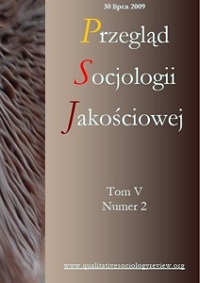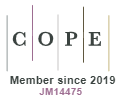Wytwarzanie ślepoty i jej organizacyjne konstruowanie w szkole podstawowej
DOI:
https://doi.org/10.18778/1733-8069.5.2.06Słowa kluczowe:
ślepota, konstrukcja społeczna, badania nad inwalidztwem, organizacja, teoria ugruntowana, etnometodologia, etnografia, ergonomiaAbstrakt
Niniejszy artykuł jest oparty na studium przypadku przeprowadzonym we włoskiej szkole podstawowej, w której obserwowano interakcje pomiędzy niewidomą dziewczynką (o imieniu Jasmine, w wieku lat 8) a jej kolegami i koleżankami z klasy. Początkowym celem badań było zrozumienie i opis problemów, z którymi spotyka się niewidoma uczennica, działająca w społecznym, organizacyjnym i fizycznym otoczeniu, które nie było zaprojektowane dla osób niepełnosprawnych. Jednak w trakcie badań wyłoniły się inne kwestie. Głównym odkryciem było to, że bycie niewidomym wydaje się być społecznie i organizacyjnie skonstruowane zanim stanie się biologiczną czy fizyczną ułomnością. Ten właśnie organizacyjny proces, poprzez który „bycie niewidomym” jest powoli i rutynowo konstruowane został dogłębnie i szeroko opisany.
Pobrania
Bibliografia
Cicourel, Aaron V. (1973) Cognitive Sociology. London: Macmillan
Google Scholar
Cicourel, Aaron V. (1996) “Ecological validity 5and white room effects.” Pragmatics & Cognition, 4(2): 221 – 264
Google Scholar
DOI: https://doi.org/10.1075/pc.4.2.04cic
Corsaro, William (1985) Friendship and Peer Culture in the Early Years. Norwood, N.J.: Ablex Publishing Corporation
Google Scholar
Davis, Lennard J. (1997) The Disability Studies Reader. New York and London: Routledge
Google Scholar
Garfinkel, Harold (1967) Studies of Ethnometodology. Englewood Cliffs: Prentice. (polskie wydanie z roku 2007, Studia z etnometodologii, Warszawa: PWN).
Google Scholar
Gilbert, Nigel and Michael Mulkay (1983) “In search of the action.” Pp. 8 – 34 in Accounts and Action, edited by N. Gilbert & P. Abell. Aldershot: Gower
Google Scholar
Goffman, Erving (1956) “Embarrassment and Social Organization.” American Journal of Sociology 3: 264 – 274. (polskie tłumaczenie z roku 2006, w Erving Goffman, Rytuał interakcyjny, Warszawa: PWN: 97 – 113)
Google Scholar
Goffman, Erving (1961) Asylums. Essays on the Social Situation of Mental Patients and Others Inmates. New York: Doubleday
Google Scholar
Goode, David (1994) A World Without Words: The Social Construction of Children Born Deaf and Blind. Philadephia: Temple University Press
Google Scholar
Goode, David (1979) “The world of the deaf-blind.” in Qualitative Sociology: A method to the madness, edited by H. Schwartz and J. Jacobs. New York: Free Press
Google Scholar
Gusfield, John (1982) “Deviance in the welfare state: the alcoholism profession and the entitlements of stigma.” in Research in the Social Problems and Public Policy, Vol. 2, edited by M. Lewis. Greenwich, CT: JAI Press
Google Scholar
Heritage, John (1984) Garfinkel and Ethnomethodology. Cambridge: Polity Press
Google Scholar
Lane, Harlan (1997) “Construction of deafness.” Pp. 153 – 171 in The Disability Studies Reader , edited by L.J. Davis. New York and London: Routledge
Google Scholar
Lester, Marilyn and Stuart C. Hadden (1980) “Ethnomethodology and Grounded Theory Methodology: An Integration of Perspective and Method.” Journal of Contemporary Ethnography 9(1): 3 – 33
Google Scholar
DOI: https://doi.org/10.1177/089124168000900101
Merleau – Ponty, Maurice (1945) Phénomenologie de la perception. Paris: Gallimard. (polskie wydanie z 2001r. Fenomenologia percepcji, przeł. M. Kowalska, J. Migasiński, posłowie: J. Migasiński, Warszawa: Fundacja Aletheia)
Google Scholar
Olson C. (1981) “Paper barriers.” Journal of Visual Impairment and Blindness 15: 337 – 339
Google Scholar
DOI: https://doi.org/10.1177/0145482X8107500807
Olson C. (1977) “Blindness can be reduced to an inconvenience.” Journal of Visual Impairment and Blindness 11: 406 – 411
Google Scholar
DOI: https://doi.org/10.1177/0145482X7707100910
Rosch, Eleanor (1978) “Principles of Categorization.” Pp. 28 – 48 in Cognition and Categorization, edited by E. Rosch and B.B. Lloyd. Hillsdale, New Jersey: Erlbaum
Google Scholar
Rosch, Eleanor (1973) “On the internal structure of perceptual and semantic categories.” Pp. 111 – 144 in Cognitive development and the Acquisition of Language, edited by T.E. Moore. New York: Academic Press
Google Scholar
Sacks, Harvey (1972) “On the analysability of stories by children.” Pp. 325 – 345 in Directions in Sociolinguistics, edited by J Gumperz and D Hymes. New York: Holt, Rinehart & Winston
Google Scholar
Sacks, Oliver (1996) The Island of the Colorblind and Cycad Island. London: Picador
Google Scholar
Sacks, Oliver (1989) Seeing Voices. A Journey Into the World of the Deaf. London: Picador
Google Scholar
Schatzman, Leonard and Anselm L. Strauss (1973) Field Research: Strategies for a Natural Sociology. Englewood Cliffs, NJ: Printice-Hall
Google Scholar
Scott, Robert A. (1969) The Making of Blind Men: A Study of Adult Socialization. New Brunswick, NJ: Transaction
Google Scholar
Siperstein, Gary N. and John Bak (1980) Improving Children’s Attitudes Toward Blind Peers, in Visual Impair. Blindness 74(4): 132 – 135
Google Scholar
DOI: https://doi.org/10.1177/0145482X8007400402
Spradley, James (1980) Participant Observation. New York: Holt, Rinehart and Winston
Google Scholar
Strauss, Anselm and Juliet Corbin (1990) Basics of Qualitative Research. Grounded Theory Procedures and Techniques. London: Sage
Google Scholar
Sudnow, David (1967) Passing On. The Social Organization of Dying. Englewood Cliffs: Prentice Hall
Google Scholar
Vaughan, Edwin C. (1998) Social and Cultural Perspectives on Blindness: Barriers to Community Integration. Springfield, ILL: Charles C. Thomas Publisher
Google Scholar
Vaughan, Edwin C. (1993) The Struggle of Blind People for Self-Determination: The Dependency-Rehabilitation Conflict: Empowerment in the Blindness Community. Springfield, ILL: Charles C. Thomas Publisher
Google Scholar
Vaughan, Edwin C. (1991) “The social basis of conflict between blind people and agents of rehabilitation.” Disability, Handicap and Society 6: 203 – 217
Google Scholar
DOI: https://doi.org/10.1080/02674649166780251
Vaughan, Edwin C. and James H. Omvig (2005) Education and Rehabilitation for Empowerment. Critical Concerns on Blindness. Greenwich, Conn.: IAP - Information Age Pub
Google Scholar
Wright, Beatrice (1960) Physical Disabilities. New York: Harper
Google Scholar
Pobrania
Opublikowane
Jak cytować
Numer
Dział
Licencja

Utwór dostępny jest na licencji Creative Commons Uznanie autorstwa – Użycie niekomercyjne – Bez utworów zależnych 4.0 Międzynarodowe.














